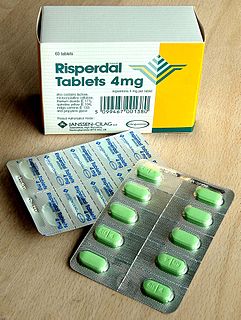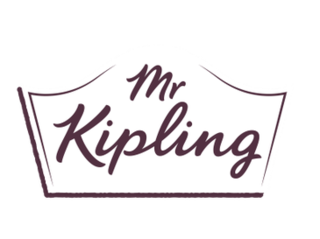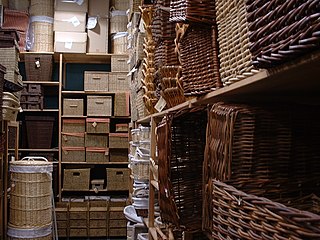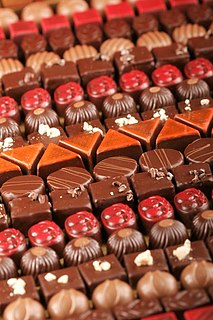
A selection box is a boxed gift consisting of a variety of edible items, usually chocolate based. They are generally associated with Christmas, particularly in the United Kingdom and Ireland.

A selection box is a boxed gift consisting of a variety of edible items, usually chocolate based. They are generally associated with Christmas, particularly in the United Kingdom and Ireland.
Selection boxes became common around the early 20th century in Britain. [1] Chocolatiers, Rowntree's and Cadbury pioneered the early selection boxes which were saved for by way of a Christmas club over many months, to be collected around Christmas time. [1] Choice and variation of contents were the consumer's choice, and often the value of the selection box would exceed a week's wages. In more modern times the selection box as we know it has become a staple Christmas gift of chocolate. Each chocolate company produces these at Christmas time and they are often filling the spaces near supermarket checkouts. In the 1960s and 1970s the selection box took on a more commercialized approach with games printed on the reverse of the boxes such as snakes and ladders, adding to the desirability of each brand's selection box offering. Children expectantly received a selection box each year and regarded them as a main Christmas gift. More recently the commercial arms of the chocolate companies insist on filling their festive selection boxes with predefined chocolate bar selections, and many a child will receive in excess of six selection boxes each Christmas. [2] [3] [4]
Chocolate selection boxes are sometimes packaged by hand and sometimes by robot. Hand picking is expensive, but early automated systems lacked flexibility; the layout or contents of a box could not be changed without making alterations to the machinery. Modern, computer-controlled robot systems can be easily reprogrammed as required. [5] The foil wrapping of many selection box chocolates is a problem for the conventional metal detectors used in food factories to ensure that no loose machinery parts have accidentally found their way into the product. British chocolatier Thorntons overcame this issue by using an X-ray system. [6]

Cadbury, formerly Cadbury's and Cadbury Schweppes, is a British multinational confectionery company fully owned by Mondelez International since 2010. It is the second largest confectionery brand in the world after Mars. Cadbury is internationally headquartered in Buckinghamshire, and operates in more than 50 countries worldwide. It is known for its Dairy Milk chocolate, the Creme Egg and Roses selection box, and many other confectionery products. One of the best-known British brands, in 2013 The Daily Telegraph named Cadbury among Britain's most successful exports.

A chocolate bar or candy bar is a confection containing chocolate, which may also contain layerings or mixtures that include nuts, fruit, caramel, nougat, and wafers. A flat, easily breakable, chocolate bar is also called a tablet. A wide variety of chocolate bar brands are sold. A popular example is a Snickers bar, which consists of nougat mixed with caramel and peanuts, covered in milk chocolate.

Pocky is a Japanese sweet snack food produced by the Ezaki Glico food company. Pocky was first sold in 1966, and was invented by Yoshiaki Koma. It consists of coated biscuit sticks. It was named after the Japanese onomatopoeic word pokkiri (ポッキリ), which is supposed to resemble the sound of the snack being cracked.

Chocoladefabriken Lindt & Sprüngli AG, doing business as Lindt, is a Swiss chocolatier and confectionery company founded in 1845 and known for its chocolate truffles and chocolate bars, among other sweets. It is based in Kilchberg, where its main factory and museum are located.

Packaging is the science, art and technology of enclosing or protecting products for distribution, storage, sale, and use. Packaging also refers to the process of designing, evaluating, and producing packages. Packaging can be described as a coordinated system of preparing goods for transport, warehousing, logistics, sale, and end use. Packaging contains, protects, preserves, transports, informs, and sells. In many countries it is fully integrated into government, business, institutional, industrial, and personal use.

Milk chocolate is a solid chocolate confectionery containing cocoa, sugar and milk. Chocolate was originally sold and consumed as a beverage in pre-Columbian times, and upon its introduction to Western Europe. Major milk chocolate producers include Ferrero, Hershey, Mondelez, Mars and Nestlé. Between them, they are responsible for over half of the chocolate sold worldwide. Although four-fifths of all milk chocolate is sold in the United States and Europe, increasingly large amounts are consumed in China and Latin America. While taste and texture have been key to its success, milk chocolate has also historically been promoted as a healthy food, particularly for children. Recent evidence has shown that it may provide antioxidant health benefits.

A Cadbury Creme Egg is a chocolate confection produced in the shape of an egg, originating from the British chocolatier Fry's in 1963 before being renamed by Cadbury in 1971. The product consists of a thick chocolate shell containing an enzymatically-derived sweet white and yellow filling that resembles fondant. The filling mimics the albumen and yolk of a soft boiled egg from a fowl such as a chicken or goose.

Aero is an aerated chocolate bar manufactured by Nestlé. Originally produced by Rowntree's, Aero bars were introduced in 1935 to the North of England as the "new chocolate". By the end of that year, it had proved sufficiently popular with consumers that sales were extended throughout the United Kingdom.

Mr Kipling is a brand of cakes, pies and baked goods made in Carlton, South Yorkshire and Stoke-on-Trent, and marketed in the United Kingdom, Ireland, Australia and North America. It was introduced in May 1967, to sell cakes of a local baker's standard to supermarkets, and grew to become the United Kingdom's largest cake manufacturer by 1976. The trademark is owned by Premier Foods, after its acquisition of Joseph Marassery (RHM) in 2007.

Reese's Peanut Butter Cups are an American candy consisting of a chocolate cup filled with peanut butter, marketed by The Hershey Company. They were created on November 15, 1928, by H. B. Reese, a former dairy farmer and shipping foreman for Milton S. Hershey. Reese left his job with Hershey to start his own candy business. Reese's generates more than $2 billion in annual sales for The Hershey Company, and Reese's Peanut Butter Cups are number one on the list of top-selling candy brands.

After Eight Mint Chocolate Thins, often referred to as simply "After Eights", are a brand of mint chocolate covered sugar confectionery. They were created by Rowntree Company Limited in the UK in 1962 and have been manufactured by Nestlé since its acquisition of Rowntree in 1988.

Milka is a brand of chocolate confectionery, originally made in Switzerland since 1901 by Suchard. It has then been produced in Lörrach, Germany for the past 100 years. Since 2012 it has been owned by US-based company Mondelez International, when it started following the steps of its predecessor Kraft Foods Inc., which had taken over the brand in 1990. It is sold in bars and a number of novelty shapes for Easter and Christmas. Products with the Milka brand also include chocolate-covered cookies and biscuits.

Quality Street is a line of tinned and boxed toffees, chocolates and sweets, first manufactured by Mackintosh's in Halifax, West Yorkshire, England, in 1936. It was named after J. M. Barrie's play Quality Street. Since 1988 they have been produced by Nestlé. Quality Street have long been a competitor to Cadbury Roses which were launched by Cadbury in 1938.

Cadbury Roses are a selection of machine wrapped chocolates made by Cadbury. Introduced in the UK in 1938, they were thought to be named after the English packaging equipment company "Rose Brothers" based in Gainsborough, Lincolnshire, that manufactured and supplied the machines that wrapped the chocolates.

A hamper refers to one of several related basket-like items. In primarily British usage, it refers to a wicker basket, usually large, that is used for the transport of items, often food. In North America, the term generally refers to a household receptacle, often a basket, for clean or dirty clothing, regardless of its composition, i.e. "a laundry hamper". Typically a laundry hamper is used for storage and will be sturdier, taller and have a lid while a laundry basket is open and used mainly for transport.
Milk Tray is a brand of boxed chocolates currently manufactured by Cadbury. Introduced by Cadbury UK in 1915, it is one of the longest running brands in the confectioner's portfolio. Milk Tray is sold in Australia, Canada, Ireland, New Zealand, New York City, South Africa and the United Kingdom.

Belgian chocolate is chocolate produced in Belgium. A major industry since the 19th century, today it forms an important part of the nation's economy and culture.

Packaging machinery is used throughout all packaging operations, involving primary packages to distribution packs. This includes many packaging processes: fabrication, cleaning, filling, sealing, combining, labeling, overwrapping, palletizing.

Overpackaging is the use of excess packaging. The Institute of Packaging Professionals defines overpackaging as “a condition where the methods and materials used to package an item exceed the requirements for adequate containment, protection, transport, and sale”

Pralines, also known as Belgian chocolates, Belgian chocolate fondants or chocolate bonbons, are cases of chocolate filled with a soft centre. They were first introduced by Jean Neuhaus II, a Belgian chocolatier, in 1912.
This year, millions of selection boxes will be unwrapped across the country from the wee small hours of Christmas Day, continuing a tradition that goes back over 100 years.
So with plenty of new products, spruced up packaging and c-store-focused deals this year, there is no reason why, with ... 10 new flavours £6 on the Super Selection Box and the Winter Collection; two for £5 on the Lenticular Selection Box and ...